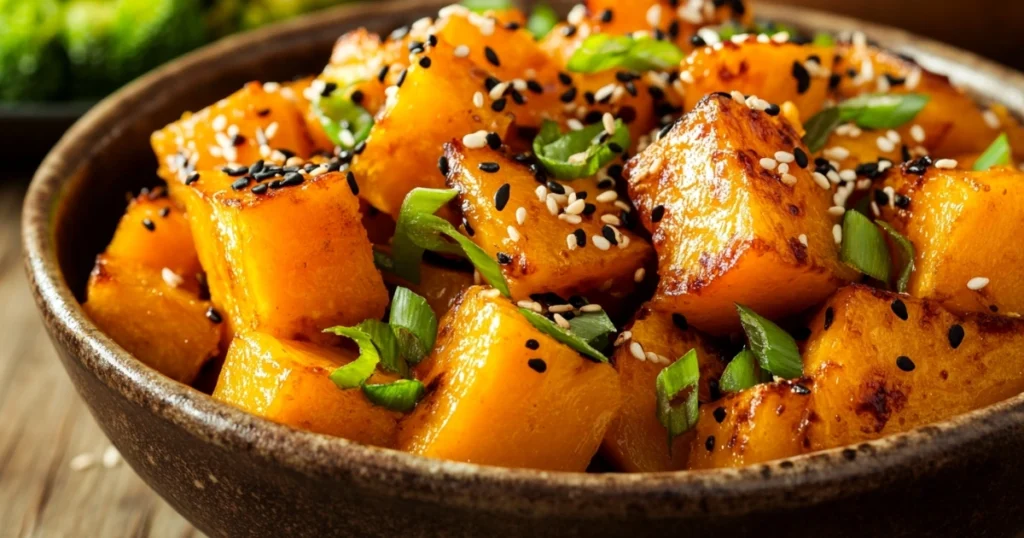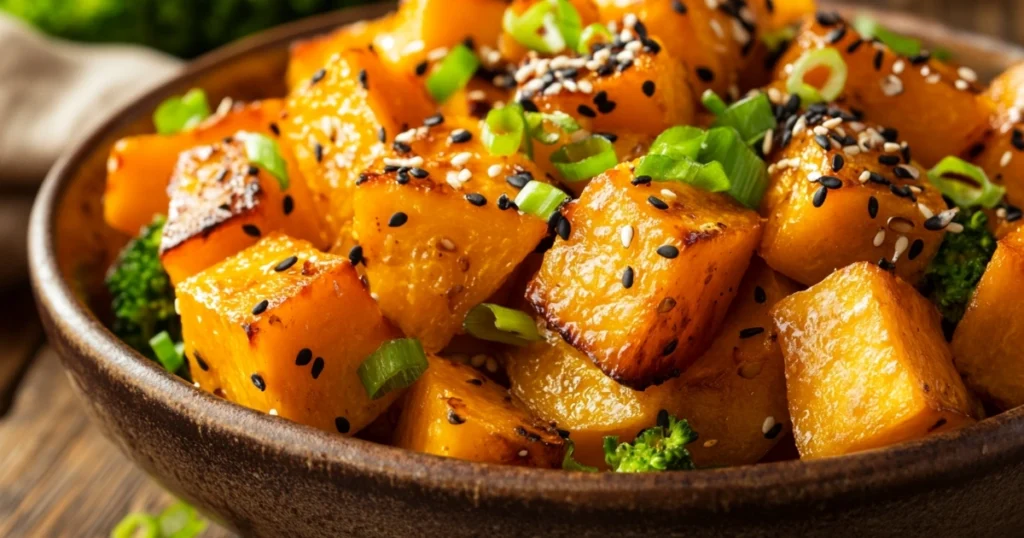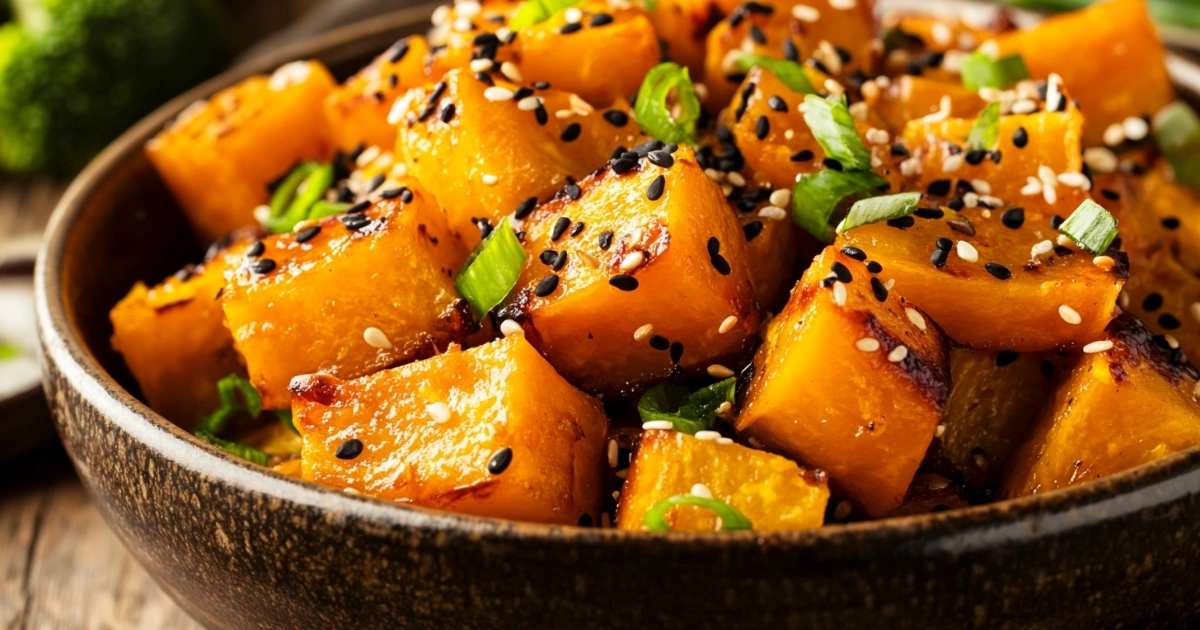As the sun sets over Beijing, the smell of kabocha squash fills the air. It invites you to dive into the world of Chinese vegan food. Kabocha, a favorite winter squash in Asia, is known for its rich taste and versatility. We’ll show you how to make easy and tasty vegan kabocha recipes, inspired by Beijing’s food scene.
Table of contents
- Understanding Kabocha Squash in Chinese Cuisine
- Essential Ingredients and Kitchen Tools
- Chinese Squash Recipes Kabocha Vegan: Classic Preparation Methods
- Authentic Wok-Roasted Kabocha Techniques
- Buddhist Temple-Style Kabocha Preparation
- Beijing-Style Kabocha Stir-Fry Guide
- Vegan Kabocha Dim Sum Variations
- Sauce and Seasoning Combinations
- Meal Planning and Serving Suggestions
- Health Benefits and Dietary Considerations
- Conclusion
Understanding Kabocha Squash in Chinese Cuisine
Kabocha squash is a key ingredient in East Asian kitchens, including Chinese cuisine. It’s loved for its sweet taste and creamy texture. This vegetable is also a symbol of nourishment and comfort in Chinese homes.
It’s packed with vitamins A and C, carotenoids, and fiber. These nutrients make it great for plant-based diets.
Nutritional Benefits of Kabocha
Kabocha squash is low in calories but full of flavor. It’s perfect for healthy eating plans. It’s rich in vitamins A and C, potassium, and fiber.
These nutrients help keep you healthy and support a vegan diet.
Selecting the Perfect Kabocha Squash
Choose a kabocha squash that’s heavy for its size. It should have a dull, dark-green skin and no soft spots or mold. A ripe squash cooks well and tastes great.
Traditional Uses in Chinese Cooking
In Chinese cooking, kabocha squash is used in soups, stir-fries, and steamed dishes. It’s often seasoned with soy sauce, ginger, garlic, and scallions. Other ingredients include fermented black beans, miso paste, and sesame oil.
It can be used in both savory and sweet dishes. This makes kabocha squash very versatile.
Essential Ingredients and Kitchen Tools
To make authentic wok-roasted kabocha vegan recipes, you need the right ingredients and tools. Soy sauce, rice vinegar, and toasted sesame oil are key. They add flavor and balance to your dishes.
Having the right cooking gear is also crucial. A strong wok is needed for the wok-roasting technique. This technique gives the kabocha squash a smoky taste. Also, a good steamer helps cook the squash gently, keeping it tender and creamy.
| Essential Ingredients | Required Kitchen Tools |
|---|---|
|
|
Following the authentic wok-roasted kabocha vegan recipe means using fresh ingredients and the right tools. This commitment to quality and technique is key. It helps bring out the full flavor and texture in your dishes.
Chinese Squash Recipes Kabocha Vegan: Classic Preparation Methods
Unlocking the full potential of plant-based kabocha squash requires mastering the art of proper preparation. From cleaning and cutting techniques to pre-cooking treatments and storage tips, understanding the fundamentals is crucial. This knowledge is key to crafting delectable Chinese-inspired kabocha squash dishes.
Cleaning and Cutting Techniques
Start by picking a blemish-free kabocha squash. Use a sharp knife to slice it in half. Then, scoop out the seeds and fibrous pulp. Rinse the squash under cool water, scrubbing it gently to remove dirt or debris.
For even cooking, slice the kabocha into uniform pieces, about 1-inch thick. Use a sturdy cutting board and a sharp chef’s knife for precise, clean cuts.
Pre-cooking Treatment
To enhance the flavor and texture of your kabocha squash, consider pre-cooking treatments. A quick blanching in salted boiling water for 2-3 minutes can help soften the skin and tenderize the flesh. Alternatively, try lightly salting the cut pieces and letting them rest for 30 minutes before rinsing and patting dry.
This simple step can help draw out excess moisture and concentrate the natural sweetness of the squash.
Storage Tips
Properly storing your kabocha squash, both raw and cooked, is essential for preserving its freshness and flavor. Uncut kabocha can be kept in a cool, dry place for up to 2 weeks. Once cut, store the pieces in an airtight container in the refrigerator for up to 5 days.
Cooked kabocha squash can be refrigerated for 3-4 days or frozen for up to 3 months. It retains its vibrant color and creamy texture.
By mastering these essential preparation techniques, you’ll be well on your way to creating delectable plant-based kabocha squash dishes. These dishes will capture the authentic flavors of Chinese cuisine.
Authentic Wok-Roasted Kabocha Techniques
Take your vegan cooking to the next level with the authentic wok-roasted kabocha recipe. This ancient method brings out the best in this Chinese squash. Known as Japanese pumpkin, kabocha is a favorite in Chinese vegan squash cooking methods. To get that perfect texture, learning to wok-roast is essential.
High heat and quick cooking are the secrets. Searing the kabocha in a hot wok gives it a caramelized outside. This keeps its natural sweetness and creamy inside. It’s not just tasty; it’s also packed with nutrients, making it a healthy vegan option.
- Begin by cutting the kabocha squash into 1-inch cubes. Keep the skin on for extra texture and nutrition.
- Heat a wok or large skillet over high heat until it smokes. Use a tablespoon of oil like peanut or avocado.
- Add the kabocha cubes in a single layer. Let them sear for 2-3 minutes, until they’re golden.
- Flip the cubes and stir-fry for another 2-3 minutes. This ensures even browning.
- Season with salt and your favorite Chinese spices, like white pepper or five-spice powder.
- Enjoy the authentic wok-roasted kabocha hot and crispy. Serve it as a side or mix it into other vegan Chinese dishes.
The secret to great traditional Chinese vegan squash cooking is high heat. It makes the kabocha’s outside caramelized and the inside tender and flavorful. Experience the rich texture and flavor that wok-roasting offers.

« The secret to delicious vegan Chinese cooking lies in the art of wok-roasting. Kabocha squash is the perfect canvas for this traditional technique, showcasing its natural sweetness and creamy texture. »
Buddhist Temple-Style Kabocha Preparation
Dive into the world of buddhist vegetarian kabocha dishes from China. These recipes blend simplicity with depth, highlighting the kabocha squash‘s versatility.
Mindful Cooking Practices
Chinese Buddhist vegetarian cooks prepare kabocha dishes with great care. They choose ingredients mindfully and cook with focus. Each step is filled with mindfulness and detail.
Traditional Seasonings
Buddhist temple-style kabocha dishes use simple yet effective traditional Chinese seasonings. The kabocha‘s natural sweetness is enhanced by soy sauce, ginger, and garlic. This method lets the ingredients’ true flavors shine, offering a nourishing and satisfying taste.
« The true essence of Buddhist vegetarian cooking lies in the ability to coax out the natural flavors of the ingredients, allowing them to speak for themselves. »
Embracing mindful kabocha preparation reveals the dish’s deep and delightful flavors. Enjoy the meditative cooking process and the balanced flavors of this temple-inspired dish.
Beijing-Style Kabocha Stir-Fry Guide
Take your plant-based cooking to new heights with this authentic Beijing-style kabocha squash stir-fry. Learning to wok-fry is crucial for getting the bold flavors and tender-crisp texture of this Chinese dish. Follow these steps to make a memorable kabocha stir-fry that will take you to Beijing’s bustling streets.
Wok Preparation and Heat Control
First, heat your wok over high heat until it smokes lightly. Add a bit of high-heat oil, like peanut or grapeseed oil, and swirl it to coat the wok. Keep the heat steady to ensure even cooking and caramelization of the kabocha squash.
Ingredient Sequencing
- Begin by searing the kabocha squash cubes until they get a slight char, about 2-3 minutes.
- Then, add minced garlic and ginger and stir-fry for 1 minute until fragrant.
- Add any extra vegetables, like sliced bell peppers or snow peas, and stir-fry for another 2-3 minutes.
- Finish by adding your seasonings, such as soy sauce, rice vinegar, and a pinch of sugar, and mix everything well.
Achieving the Perfect Balance
The secret to a true Beijing-style kabocha squash stir-fry is finding the right mix of sweet, sour, and savory. Try different sauces, spices, and aromatics to find the flavor that excites you.

The key to a great kabocha squash stir-fry is in the prep and technique. With practice, you’ll make dishes as good as those in restaurants, highlighting the natural sweetness and health benefits of this versatile veggie.
Vegan Kabocha Dim Sum Variations
Discover the fun of vegan kabocha squash in dim sum recipes. These small treats are great for showing off the squash’s sweet taste and creamy feel. You can try traditional steaming or new fillings to make your vegan kabocha dim sum special.
Steaming Methods
Getting the right texture for dim sum is all about steaming. Use a bamboo steamer basket for a traditional feel. It helps the kabocha steam softly and become soft and fluffy. You can also use stainless steel or silicone steamer inserts for good results.
Don’t forget to line your steamer with parchment paper or cabbage leaves. This stops the dim sum from sticking.
Filling Options
- Mashed Kabocha: Blend cooked kabocha squash until smooth. Mix it with soy sauce, sesame oil, and ginger for a tasty filling.
- Kabocha and Mushroom: Sauté mushrooms with mashed kabocha. Add garlic, soy sauce, and chili oil for extra flavor.
- Kabocha and Tofu: Mix crumbled tofu with mashed kabocha. Season with scallions, sesame seeds, and tamari for a protein-rich filling.
- Kabocha and Vegetable: Add diced carrots, bell peppers, and water chestnuts to the mashed kabocha. This makes a colorful and textured filling.
Try different wrappers like wheat, rice paper, or wonton wrappers to make your own vegan kabocha dim sum. Adjust the steaming time to get the perfect texture.
With vegan kabocha squash, you can make many tasty and beautiful dim sum dishes. They will make your taste buds happy and impress your friends. Enjoy making vegan dim sum and let the kabocha squash be the star of your dishes.
Sauce and Seasoning Combinations
Discover the secret to making chinese squash recipes kabocha vegan dishes shine. The right sauce and seasoning combinations are key. Learn how to use traditional chinese vegan squash cooking methods to take your kabocha dishes to the next level.
Garlic sauce is a favorite for kabocha squash in Chinese cooking. It’s made by sautéing garlic in oil and mixing it with soy sauce, rice vinegar, and a bit of sweetener. This creates a savory-sweet sauce that enhances the squash’s natural sweetness.
If you prefer tangy flavors, try a sweet and sour sauce. Mix rice vinegar, ketchup, soy sauce, and a bit of chili. This sauce adds a tangy contrast to the tender squash.
- Garlic Sauce: Minced garlic, soy sauce, rice vinegar, and a touch of sweetener.
- Sweet and Sour Sauce: Rice vinegar, ketchup, soy sauce, and chili.
- Black Bean Sauce: Fermented black beans, garlic, ginger, and soy sauce.
Take your chinese squash recipes kabocha vegan to the next level with herbs and spices. Ginger, scallions, and Szechuan peppercorns add depth and intrigue. Five-spice powder or chili flakes bring a nice contrast with their earthy or spicy flavors.
« The key to mastering traditional chinese vegan squash cooking methods is to embrace the natural flavors of the kabocha squash and let them shine through, while gently guiding them with the right sauce and seasoning combinations. »
Try different flavors and find the perfect mix that excites your taste buds. These chinese squash recipes kabocha vegan will leave you wanting more.
Meal Planning and Serving Suggestions
Chinese kabocha squash is perfect for meal planning. It can be the main dish or a side in many vegan recipes. Pair your kabocha dishes with sides that bring out its flavors and textures.
Complementary Side Dishes
- Steamed or stir-fried Chinese broccoli or bok choy
- Fragrant jasmine or brown rice
- Marinated tofu or tempeh for added protein
- Fresh cucumber, carrot, or cabbage salad with a light vinaigrette
- Sautéed mushrooms or snow peas
Presentation Tips
Make your Chinese kabocha squash dishes look great on the plate. Arrange the squash neatly and add fresh herbs like cilantro or scallions. For kabocha soup, use a decorative bowl and garnish with toasted pumpkin seeds or sesame oil.
Plan your meals with chinese kabocha side dishes in mind. This way, you can enjoy a balanced and delicious vegan Chinese meal. It’s a great way to celebrate this amazing vegetable.
Health Benefits and Dietary Considerations
Adding chinese squash recipes kabocha vegan to your meals can be very beneficial. Kabocha squash is a favorite in Chinese cooking. It’s not just tasty but also packed with nutrients. Its bright orange flesh and creamy texture make it perfect for vegan kabocha soup and other dishes.
Kabocha squash is rich in vitamins and minerals. A 100-gram serving has lots of vitamin C, which helps with growth and repair. It also has potassium, which is good for the heart. Plus, it has carotenoids that protect the eyes and fight off free radicals.
This squash is also great for blood sugar control because of its low glycemic index. Its fiber helps slow down sugar absorption, which can help manage blood sugar. Magnesium in kabocha squash also helps with glucose metabolism, which is good for people with diabetes.
| Nutrient | Amount per 100g |
|---|---|
| Calories | 49 kcal |
| Carbohydrates | 12g |
| Fiber | 1.8g |
| Protein | 1.6g |
| Vitamin C | 9mg |
| Potassium | 350mg |
| Iron | 0.7mg |
But, eating too much kabocha squash can cause carotenemia, making your skin look yellow or orange. People with allergies should talk to a doctor before eating it.
In summary, chinese squash recipes kabocha vegan are great for a healthy, plant-based diet. Kabocha squash is full of nutrients and can be used in many ways. It’s a tasty and nutritious choice for adding more veggies to your meals.
Conclusion
In this article, we’ve explored the world of chinese squash recipes kabocha vegan. We’ve seen how delicious and versatile this squash is in beijing-inspired dish. Kabocha, or Japanese pumpkin, is packed with vitamins, fiber, and antioxidants. It’s a great choice for those who care about their health.
We’ve learned about kabocha squash’s role in Chinese cooking. It’s used in stir-fries, soups, dumplings, and congees. By learning how to wok-roast and prepare it, you can bring out its full flavor. This makes it easy to create tasty, plant-based dishes.
As you keep exploring chinese squash recipes kabocha vegan and beijing-inspired dish, enjoy the flavors and health benefits of kabocha. Try different cooking methods and spices to find your favorite dishes. Adding kabocha to your cooking can make your meals better and help the planet. Start your journey of discovering kabocha squash in Chinese cuisine!

